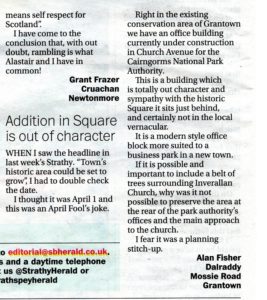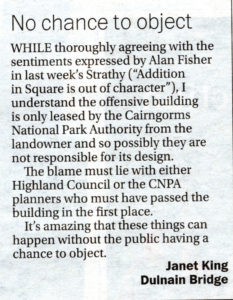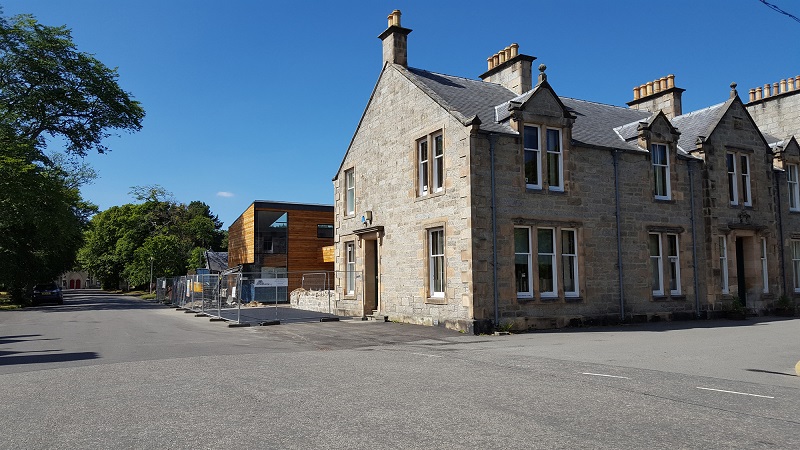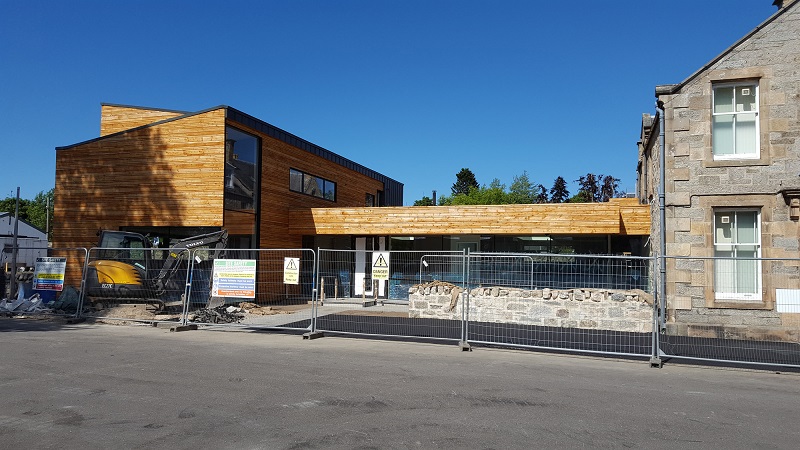
The replacement extension to the Cairngorms National Park Authority HQ, which is now close to completion, has been attracting some critical comments in the Strathy.


The building, which the Cairngorms National Park Authority leases, is owned by Reidhaven, more commonly known as Seafield Estates, which owns much of the land hereabouts. The Planning Application was made in their name and decided in 2016 by Highland Council (see here) – entirely appropriate because of the conflict of interest had the CNPA decided it.
Much of what people like and dislike about architecture is a matter of taste, rather like what people find funny or not, though the majority of folk do tend to like buildings made out of natural materials.

When I first saw the extension, then in the process of construction, a few months ago it was from the front, the Square. From this angle, the building was partially concealed and the wood formed a transition, if you like, with the green trees behind.
Personally, like the original building, I find the extension, in itself, quite attractive. The issue with the CNPA HQ comes from the juxtaposition of two very different types of natural materials and two very different forms (compare the shapes of roofs and windows).

To me the very different materials and shape jar. While the Planning Report claims that “Over time the cladding will weather to a silvery grey colour, complementing the stonework of the main building” this is somewhat contradicted by the statement that “The proposed extension is unashamedly contemporary. Inevitably such a modern intervention in the historic environment will not be without its critics”. It appears the building was meant to jar.
The new extension replaced an older one, the CNPA had run out of space with 10 staff transferred to Grantown from Ballater, and before deciding on the preferred design 15 different options were considered. The evaluation presented to the Highland South Planning Committee concluded:
Effect of proposals on conservation area
There is no dispute that the existing extension which projects from the rear elevation in line with the gable elevation of the main building contributes to the main building’s pivotal role in preserving the conservation area at this prominent location. The key question however is whether the redevelopment of the site with the new extension preserves or enhances the designated conservation area.
Construction of the proposed extension will create an innovative modern building utilising high quality materials, creating a bold visual statement contrasting with the established traditional design of the main building but nevertheless deferential to its setting. Whilst the design will inevitably divide opinion it is difficult to argue that the proposal will not be seen as an exemplar of innovative design, befitting its role as the public face of the CNPA’s headquarters.
It is considered that the proposal, if implemented, will both preserve and enhance the conservation area within which it is sited
The claim that the new building would be “deferential to its setting” appears to me vacuous in the absence of any examples of irreverent designs which Highland Council would turn down.
Whether this assessment was compatible with the CNPA’s policy 9, on the Cultural Heritage, as set out in their Local Development Plan, was the central issue at stake:
The layout, design, materials, scale, siting and use of any development will be appropriate to the character and appearance of the structure or asset and its setting.
If you can judge the construction of a radically different extension near the centre of what was a designed settlement and protected as such to be appropriate to the character and appearance of the setting, then its hard to see why you cannot build any design anywhere. The CNPA has in my view helped drive a giant hole through its own policy and thereby not just affected the appearance of an historic town centre, its also created a rod for its own back. Other developers will simply adapt the form of words used to justify this development for their own proposals and the CNPA will find it hard to object without the design of the building they lease being thrown back at them.
The Highland Council Planning Report records that one comment was made on the application at the time, from the Grantown society:
Design interesting and innovative but inappropriate to historic environment setting
A fair summation of what has happened. When they received this comment, the CNPA and HIghland Council would have been wise to have consulted more widely rather than assume the lack of objections meant people were happy with the proposals. I suspect the letters to the Strathy may be the tip of an iceberg in terms of public opinion locally.

I don’t understand why only one comment on what is a major development in Grantown was received . I live in Aberdeen where the weekly list of planning applications submitted is published in the Press and Journal, but the lack of response to this one indicates that Highland Regional Council does not publicise applications in the local paper. I would like to think that they are publicised in some way, other than appearing on the Council’s website, so that the public doesn’t have to seek them out.
You make a good point, Susan. Local planning applications are published in the ‘Strathy’, a local paper, but this is not that widely read. Also I perceive that there is apathy on such matters in the local area. There is a history of planning consultations where little heed is taken by the planners to public comments and objections, including objections from Community Councils. Never mind, there is a consultation document out for review at the moment on changes to the Grantown on Spey conservation area – see http://consult.highland.gov.uk/portal/environment/grantown_ca_appraisal/ – I think it is called ‘shutting the stable door after the horse has bolted’.